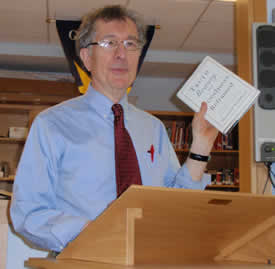Howard Gardner, Harvard Professor Speaks at The School at Columbia
By Leah Metcalf
 |
| Harvard Professor Howard Gardner |
Howard Gardner, a professor at the Harvard Graduate School of Education and the creator of multiple intelligences theory, opened the education technology conference Teach 21 at The School at Columbia University by sharing thoughts from his new book, “Truth, Beauty and Goodness Reframed.” According to Gardner, these fundamental social values are being redefined in the digital age.
Modern skepticism and relativism, he argued, complicate educating “for the virtues,” he said. Today’s youth, raised in the age of Jon Stewart, more readily question what they’re told and more easily run into situations where traditional notions of ownership and responsibility are challenged, he said.
Gardner believes that school is where students develop the understanding of how to be an ethical person and gave recommendations on how educators should teach these virtues. Each profession has its way of looking at the world and of understanding what truth is, Gardner said. For example, historians determine what’s true by looking at records and piecing them together; scientists determine their truths through experimentation and observation.
According to Gardner, things are beautiful if they are interesting, have a memorable form, and make the viewer want to revisit them. In his presentation, he alluded to many works of art and music that have become cultural touchstones and are instantly recognizable, including Claude Monet’s water lily paintings and Jackson Pollock’s drip paintings. Gardner said that with the advent of technology, the idea of the “traditional canon” of work is over. What’s important is for people to develop individual portfolios of what they like, what they’ve been exposed to and how “our palate of beauty grows and evolves,” he said.
Gardner cites three requirements for something to be good: it must be technically excellent, personally engaging, and carried out in an ethical way. The challenge presented in the 21st century for students is to understand how to be not just a good neighbor, but also a good citizen of the world. To be a good citizen of the world, a challenge that most students encounter on the Internet, students have to learn how to engage in “good play”: how to form a sense of identity, how to understand the role of power, how to deal with questions of ownership and authorship, how to earn trust, and how to participate in the community.
Gardner recommended commonsensemedia.org, as well as his most recent research project, The Good Work Project (goodworktoolkit.com), as places that serve as a commons for educators to discuss ethical issues, what works and what doesn’t in their classrooms, and how to deal with these challenges.
The best way to deal with these questions is to open the discussion with students, and to affirm the value of these virtues in your conversations with them. “We should strive to become good workers and good citizens, not just within our own society, but across the global community,” he said. #
